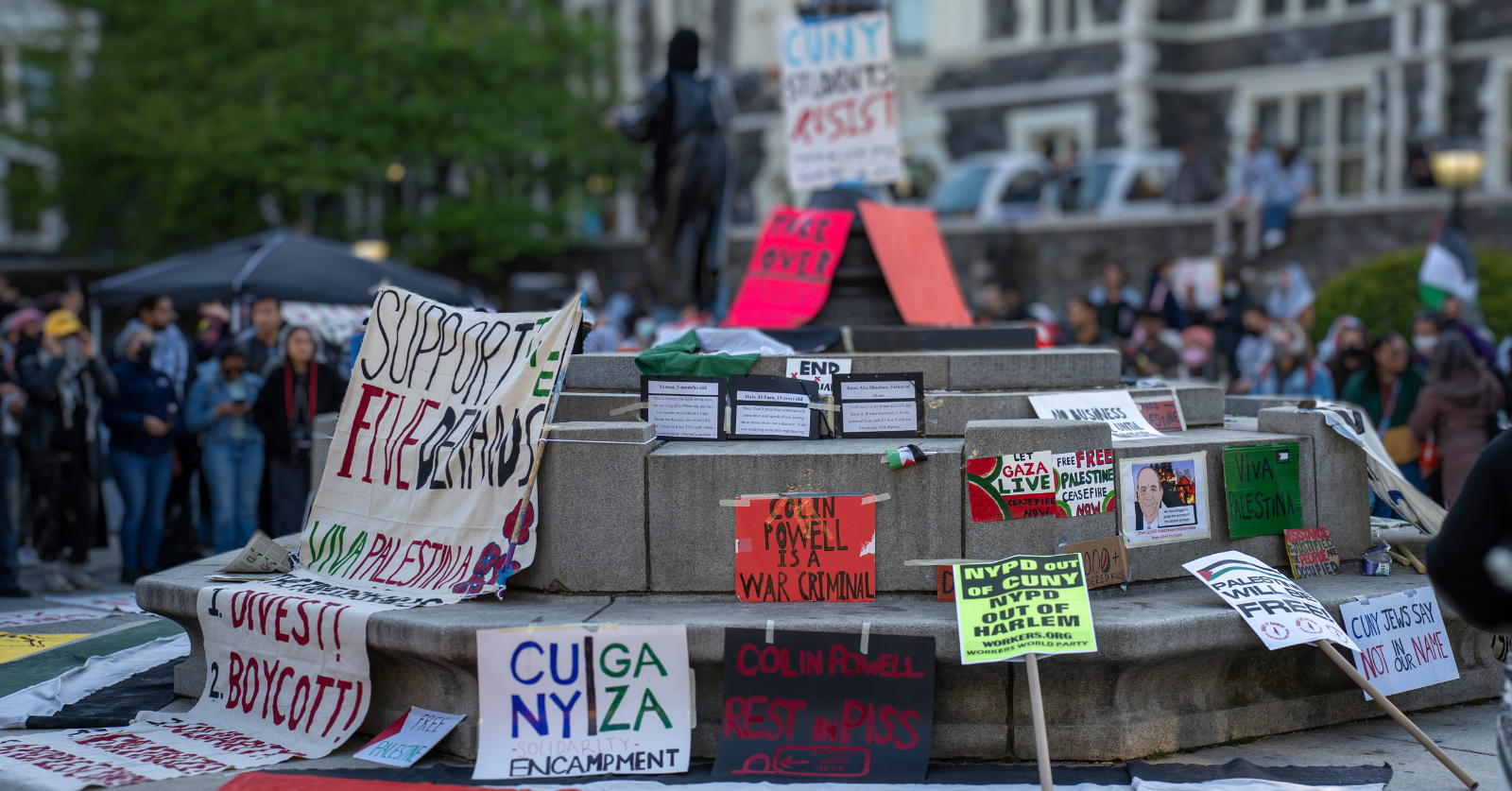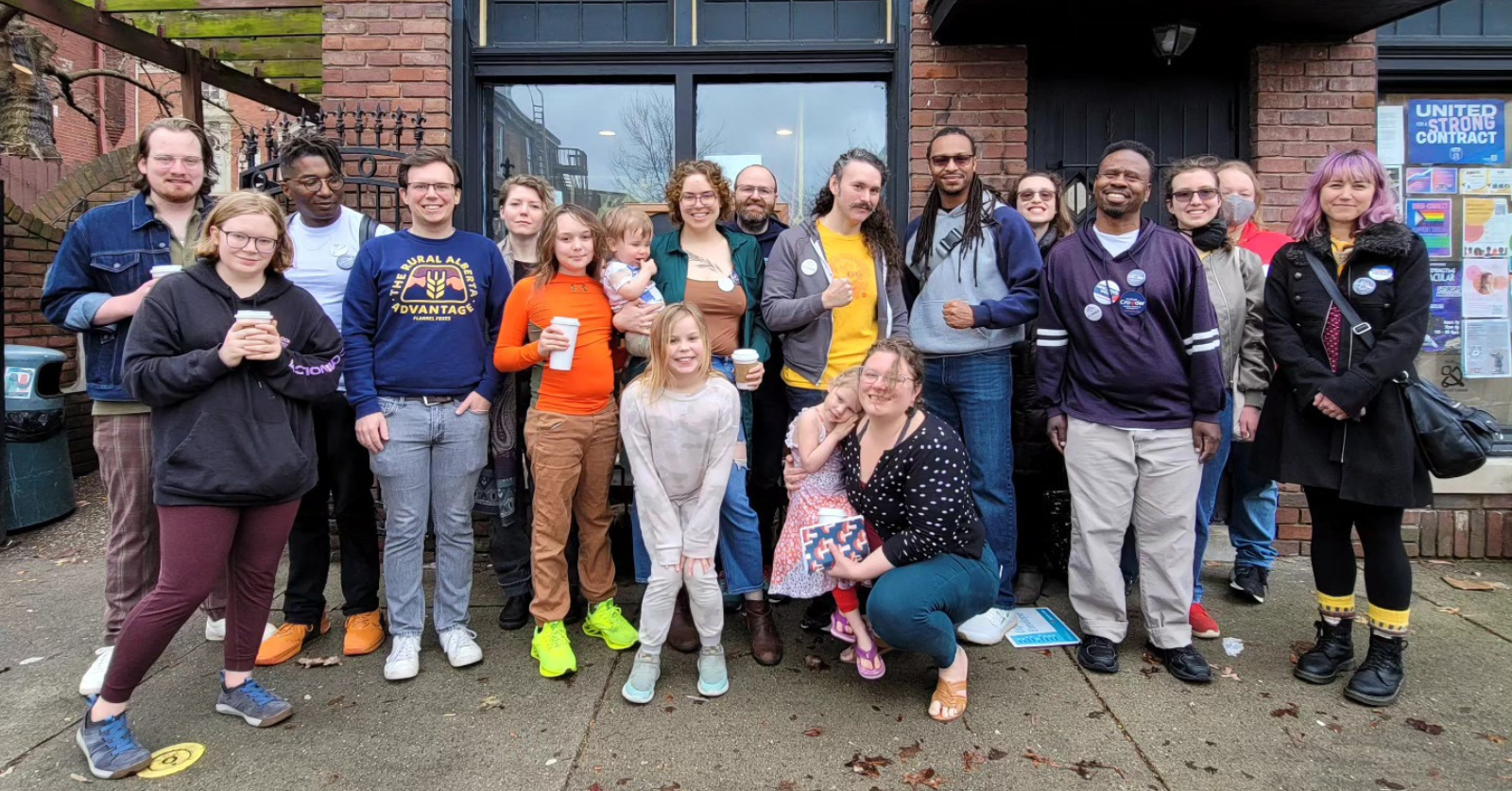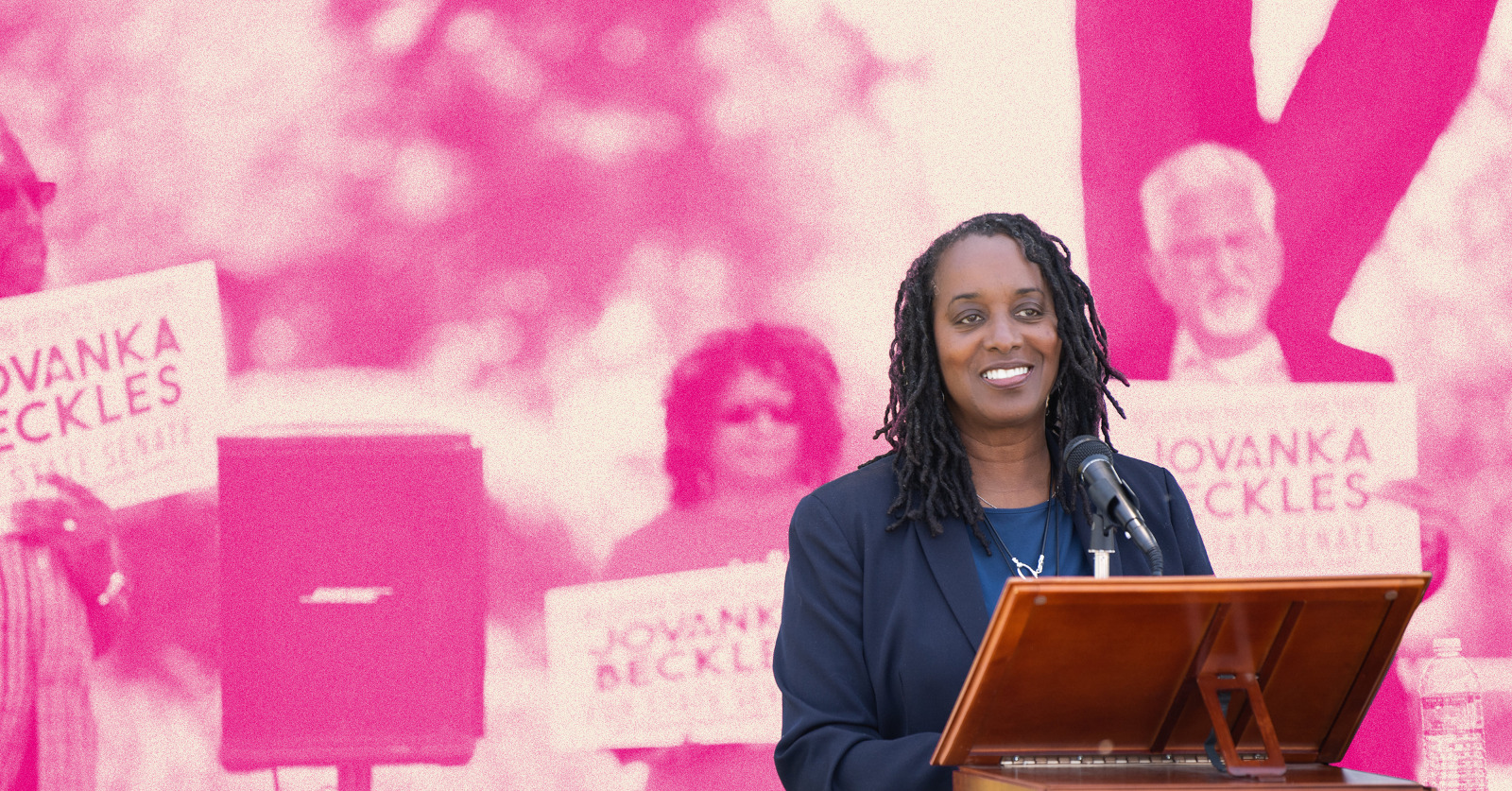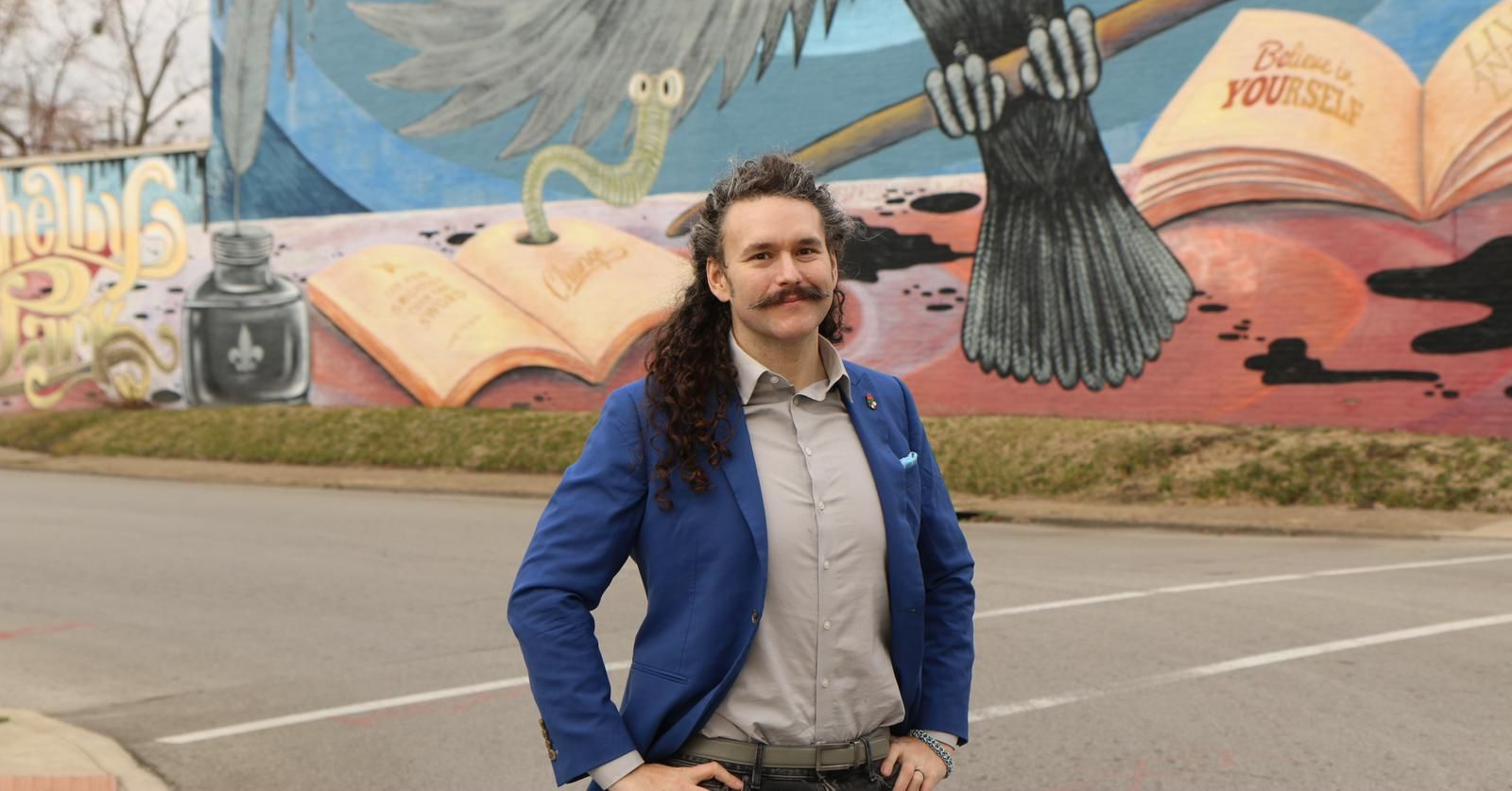For six days, the City University of New York (CUNY) community held an encampment at the City College of New York (CCNY) in solidarity with Palestine. Despite police repression, the solidarity movement in Palestine is building power and comradely bonds across diverse identities and sectors of the working class. This text was originally published in Portugal and Uruguay after the police repression of the CCNY encampment on May 1st. It is our firsthand account of those days.
On Tuesday afternoon, April 30th, a student leader stands with a megaphone on the central platform of the City College’s campus square in Harlem, northern Manhattan. “We have received an ultimatum: the university demands that we dismantle the encampment by tomorrow morning.” She continues sharing the content of an email from the university administration that the leadership of the Gaza Solidarity Encampment had just received. “We must decide collectively whether to yield to the administration’s threats or to defend our camp courageously!” Around her, tension rises in the newly formed assembly, which speculates about whether and when the police will intervene and potentially dismantle the camp, now on its sixth day. “What is the plan to defend the camp from the police?” asks Nour, concerned. A PhD candidate studying the history of Middle Eastern pop culture, Nour has been camping there with many students and community members since Thursday. Neither the student leaders nor any member of the encamped community seems to have a concrete plan to face the looming threat of state intervention.
On the central platform’s mast, a fluttering Palestinian flag challenges the legitimacy of the official American one positioned a few meters above. Surrounding the platform, several dozen tents are spread across the grassy esplanade, interspersed with makeshift facilities for food distribution, hygiene products, political pamphlets, and a library where authors such as Rosa Luxemburg and Jorge Luis Borges live together. The organizational sophistication has significantly developed since the previous Thursday when students, professors, alums, and community members set up tents in solidarity with Palestine. The City College campus is just one of many that make up the City University of New York (CUNY), the largest educational institution in the city. CUNY educates about 275,000 working-class students of diverse religious, ethnic, and national backgrounds, earning it the nickname the “Harvard of the proletariat.”
This camp is part of a wave of student protests that began at Columbia University in New York on April 17th. This movement continues the numerous marches that have taken place through the city streets in solidarity with the Palestinian people since October 2023. The peaceful protest camps now extend to nearly a hundred university campuses. Police repression has led to over 2,000 arrests, marking this as the most significant student movement in the United States in the 21st century. The goals of these university encampments are to demand an end to the genocide in Gaza and to oppose sanctions against public support and opinions in solidarity with Palestine from professors and students. Another key demand is divestment, urging the cessation of economic support to the State of Israel by university endowments.
At Columbia, the camp has signs reading “liberated zone,” reminiscent of the protests against the Vietnam War when students occupied several buildings before being arrested. Similarly, in the City College central platform, the cold spring summer lightens up a panel with the encampment’s five Demands. That is the same number of demands of the civil rights protests at that college in 1969, which challenged the discrimination against African-American and Puerto Rican students in accessing higher education. Today’s five demands are divestment, boycott of Israel, solidarity, demilitarization, and a CUNY for the people. The voices of the civil rights movement also echo in the encampment. On Friday 26th, Mumia Abu-Jamal speaks to the encampment over the phone from the prison where he has been since 1981 following a racially-biased trial. “Do not bow,” summons the former Black Panther after discussing the connections between the Black liberation struggle and the Palestinians’ fight against oppression. The comparisons with past students’ movements are constant. “Today, like in the 60s and 70s, the student movement plays a catalytic role in expressing discontent,” proclaims Daniil through a megaphone on the platform. A student at Hunter College at CUNY and member of the Democratic Socialist of America, Daniil leads a teach-in on a 1970s speech by Peter Camejo addressing the student movement against the Vietnam War. “Students, with their family and community connections, are key against political apathy! They force people to take a stand!” Daniil adds, highlighting the transformative potential of students.
Despite the parallels with the student protests against the Vietnam War and for civil rights, many of today’s protesters are not directly involved in the conflict. In the 1960s and 1970s, the threat of being drafted and the legacy of the Jim Crow laws added personal stakes to the fight. Today, personal connections to Palestine are tenuous for many of these students today. The student movement sweeping US universities is fundamentally a broad international solidarity movement.
The political left and trade unionism are markedly present in this broad movement. On Sunday, April 28th, nearly 200 teachers and rank-and-file workers from the Professional Staff Congress (PSC), the union representing CUNY workers, gathered in an assembly at the camp. They demanded that the union leadership endorse the students’ demands and called for an informal strike on May 1st. “We need to mobilize a large number of people. The Taylor Law forbids us from striking, but our experience shows that when mobilization is substantial, no law can stop us,” declared a middle-aged professor from Brooklyn College.
Nevertheless, the convergence of groups extends well beyond students, professors, and PSC members. The camp’s program and assemblies draw unionists from diverse sectors, including Starbucks, Teamsters at UPS, and New York’s public transit union. The diversity is also religious and ethnic. There is matzah, grape juice — adhering to the camp’s alcohol-free policy — and various kosher and non-kosher dishes on Friday night. It’s Shabbat, celebrated both in Hebrew and English. A few yards towards the south, on the plaza’s lawn, Muslim men and women, in separate groups, kneel in prayer. There are six people arranged around the women. A Puerto Rican flag wraps one of these six. They hold keffiyehs and other scarves at chest height, creating a barrier to provide privacy from onlookers and the cameras of doxxers. Just the day before, a van of doxxers had circled the encampment, displaying on huge LED panels the faces of students involved in the solidarity movement to intimidate them.
These destabilizing groups are a common occurrence in student camps. In the early hours of Wednesday, May 1st, pro-Israel extremists violently attacked the solidarity camp at the University of California, Los Angeles (UCLA). Neither the police nor UCLA security intervened as the attackers launched fireworks at the camp and assaulted the students with tear gas, batons, and stones, according to a report by Al Jazeera. Similar skirmishes with pro-Israel provocateurs also occur at City College, which reveal tensions between the encampment and police forces. Monday night brings upheaval; around 1 a.m., a group of provocateurs enters the College. Feeling threatened, some camped students notify campus security. This occurs despite the encampment protocol that forbids communication with security forces except by designated students. Reports on the subsequent events are inconsistent. But it is clear that the complaint led to an increased police presence around the campus, and the only person detained by the authorities was an African-American pizza delivery man who was simply passing by. It is a bitter but all too familiar story for the CUNY student community, well aware of their inability to rely on police amid this institutional racism.
At Tuesday’s assembly, the campers discuss what to do. We are on the central platform following the announcement of the ultimatum to leave the campus. Everyone calls for mobilization in the face of the imminent danger. “We will manage to defend the camp. But we, the working class, need to mobilize massively. The camp will only survive with a mass of people,” states Tatiana, an adjunct professor at Brooklyn College, under the two increasingly conflictual flags. We need to map out our colleagues and contact them! One by one!” suggests Oren, a high school teacher and member of DSA’s Bread & Roses caucus. The decision to continue the camp despite the ultimatum is unanimously approved. However, the applause cannot hide the visible concern among the attendees. If it exists, the defense plan is unclear. But preparations are made for the worst-case scenario. A CUNY law student takes the platform and provides attendees with a crash course on handling potential arrests. A first aid talk follows — knowledge many will need to apply sooner than expected.
A few minutes later, Nour methodically organizes camping gear in a corner of the encampment and defines evacuation plans for migrant students who cannot risk arrest. “If you have a student visa, getting arrested is the last thing you want to happen to you,” he says. The agitation grows. A Within Our Lifetime group (WOL) march arrives at one of the campus gates. After learning about the ultimatum, WOL went to northern Manhattan to support the City College camp. Police forces gather at the main entrances, suggesting they will carry out the CUNY administration’s eviction threat sooner than announced. The police surround the campus with metal fences, and the vans for transporting detainees gather in the parking lot. According to the latest messages on cell phones, police convoys are approaching the place. By then, the community is sure that the police invasion is imminent. Allegedly, as a last resort to stay on campus, a group of students attempts to take over an administrative building.
For the mayor of New York and former police officer Eric Adams, these protests are not just student protests. As he says in a news conference on Wednesday, May 1st, they are the product of “outside agitators who trained and co-opted the movement.” According to him, the New York police entered universities to expel “those who turned a peaceful protest into a space of anti-Semitism and anti-Israel attitudes.” The next day, Joe Biden will justify police interventions under the pretext that violently protesting is not a constitutional right.
At City College, the presence of “outside agitators” is evident. “Outside agitators” are the solidarity and care networks extending beyond the camp. Some agitators are neighbors. In recent days, an avalanche of people has visited the grocery store where Naas works in front of the campus. One of the College administration’s strategies to discourage communities from continuing camping is prohibiting access to campus bathrooms. Quickly, “outside agitators” who work in the area’s grocery stores — delis in the New York lexicon — made up for the lack of bathrooms. “SOAP HERE,” reads a makeshift paper sign in one of the Delis on the other side of Amsterdam Avenue. Naas and his Yemeni colleagues warmly welcome the activists. “Come whenever you want; thank you for being here,” Whalid tells one of the student campers. For Naas, this is his way of participating in the movement while he works. “We do our duty. What is happening in Palestine is unacceptable, regardless of religion or race… We are against the genocide and in favor of humanity, and it is our duty to contribute to these protests.” Other contributions come from family members, like Chandni’s mother: “It’s part of the community nature of CUNY. Many people contributed with monetary donations, legal support, but also food. My mother made a lot of Biryani for people to eat and left a note on the plate telling the students that they have the power and are the force of change,” shares Chandni the day after the police forces truculently dismantled the camp.
After the attempt to take the building, university security repelled the occupation. Once police sieged the campus, it was clear to the campers that the cops’ invasion was about to happen. Fearing arrest, many campers left the campus and gathered on Amsterdam Avenue near the entrance. For several hours, a few dozen students remained inside the campus, while hundreds of people continued to gather outside to demonstrate against the police intervention and the dismantling of the camp. It was night already when the police began attacking the thriving demonstration. They had no problem using batons and tear gas to break up the crowd. The attack was led by NYPD’s Strategic Response Group, well known for its brutality against protesters. They lived up to their reputation. Although the number of injuries is unknown, there are accounts on social media about broken legs and teeth. Before dawn, the camp had been dismantled, and the number of protesters arrested reached 170 people.
Comparing the “outside agitators” discourse of New York Mayor Eric Adams to Chandani’s mother, one finds a very different country. There is the country of warlords: that of Eric Adams, Joe Biden, Benjamin Netanyahu (who has Israeli-American nationality), university administrators, and the Strategic Response Group, for whom police brutality is the rule and peaceful protest is “terrorism” by “outside agitators.” In the other country, we find Chandni and her mother, Naas, Nour, and everyone participating in this movement. There are Jews, Muslims, secular Arabs, atheists, people of all ethnicities, and diverse political sensibilities, for whom solidarity is their flag and comradery their language.
That’s what Nour, born in southern Lebanon, tells us. We are on the sidewalk of the Naas Deli the afternoon after the police attack. Nour says:
“Perhaps the greatest blessing of this movement is its plurality and what we can learn from it. There were tensions between sensibilities, a productive tension different from what happens in the Levant and the Middle East. There is a generation of Muslims, Pakistanis, Palestinians, Yemenis, etc., who grew up in the United States after 9/11, who saw family members tortured in Guantanamo, who grew up under surveillance and police brutality. State oppression and racism brought them together in a way that does not happen in the Middle East, where solidarity is imagined but not always practiced. Here, Islam creates a certain communal unity between people of different nationalities. From the oppression, these communities derived a religious and cultural performance that is also political, that has friction in its internal plurality, and that also comes into conflict with the political and social practices of secular Arabs like me.”
Even so, Nour reminds us that this movement teaches us to create political ties.
“In the first days, the tensions were greater: for some, playing music, smoking, or drinking alcohol generated discomfort; it was haram; it was wrong at this time of mourning. For others, if there were no joy and pleasure in the struggle, we would not advance. But these tensions are not the clash of civilizations that the conservative right has invented. They exist within religious and non-religious groups and among those who grew up inside and outside the United States. The transformative experience occurred by working on these differences, building a space where everyone counts and no one is ostracized. On Friday, on one side, there was the Jewish community celebrating Shabbat; on the other, the Muslims prayed; and I, in the middle, prepared the DJ set that I would play later.”
And so it happened. Later, everyone met to watch a documentary about the Nakba and discuss the student movement’s strategies for the future. Because, for these activists, there is a strategic and transformative horizon, and these encampments bring us closer to it. According to Nour, “There are several political projects for Palestine and the world worth fighting for, and I have mine. But the comradery forged in these camps’ plurality is the way forward. And we will continue.”
This text was originally published at Esquerda.net and Zur.uy.




